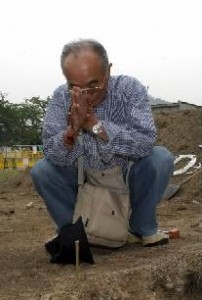Ninoshima Island, Awakening from Slumber, Part 1
Jun. 28, 2010
Dark brown bones awaken the past
by Kunihiko Sakurai and Aya Kano, Staff Writers
Fifty-nine years after the dropping of the atomic bomb [this series was originally published in July 2004], the remains of many atomic bomb victims are being found on Ninoshima, a small island off the coast of Hiroshima. The fact that they are just now being exhumed reveals the vast scope of the devastation wrought by the bombing. The brittle, dark brown bones are reminders of the long years that have elapsed, forgotten by the public. In this series the Chugoku Shimbun examines how we should remember the atomic bombing experience and how we should convey that experience to the next generation.
With each shovelful of dirt, the workers unearthed bones ranging in length from a few centimeters to as much as 40 centimeters, one after another. The roots of trees ran through or around some of them. Among the bodies waiting to be unearthed were skulls lying in the dirt facing up or to the side. After 59 years of slumber, the skulls and their teeth have turned dark brown.
Just after the atomic bombing, about 10,000 injured people were transported to Ninoshima. Perhaps due to the overwhelming number of victims, they could not all be cremated. Thus, they were buried here, one on top of another. Although the workers pick up the bones carefully, because they are brittle, some of them break or crumble.
"It's sad that they were left like this for so long," said Toshinori Jigo, 69, a Hiroshima resident, as he squatted beside the site on June 24. He stuck several sticks of incense in the ground, and clasping a Buddhist rosary, offered a prayer.
Mr. Jigo still does not know what happened to his brother Masaaki, then a first-year student at the former Hiroshima First Middle School (now Kokutaiji High School). He went off to help with the dismantling of buildings to fashion a fire lane and never returned.
Nine days later, on August 15, their mother Kimie, 93, went to Ninoshima after hearing that Masaaki had been taken there. All she gained was a death certificate a soldier gave her. Now a resident of a Hiroshima nursing home, Kimie choked out an expression of gratitude when her son told her he had gone to Ninoshima to see the excavation work. Evidently remembering Masaaki, who was 13 at the time, she could not stop crying.
Akio Ikeda, another first-year student at the same school, is known to have died on Ninoshima three days after the bombing. He was 14. His mother Haruyo hurried to the island, and an army doctor she was acquainted with located her son for her. She could hardly recognize him. He had died one hour before. His mother had the doctor cut off his right ring finger and she put it in a bottle and took it home with her for burial in the family grave.
Akio's brother Kazuyuki, 69, who has remained in Hiroshima, now visits the island every year on the anniversary of his brother's death instead of their mother, who has died. He also attended a memorial ceremony for the first remains discovered during this excavation, which was held on June 3 in front of the Atomic Bomb Memorial Mound in Peace Memorial Park. No other family members of the victims were present. "Fewer and fewer people remember those days," Kazuyuki said. "It's sad. And it's frustrating not being able to do anything."
According to city estimates, the remains of 617 bodies were exhumed during an excavation of the adjoining land on Ninoshima in 1971. Sixty-one personal items that had belonged to the victims were also unearthed. Seven of the victims could be identified based on the personal belongings that were found.
"It was rusty, but I knew right away it was my brother's buckle," said Akio Hayashi, 76, a resident of Higashi Hiroshima City, recalling that day 33 years ago. The picture of an American Indian on the buckle was the distinctive feature. Mr. Hayashi's brother Haruyuki was a first-year student at the Municipal Shipbuilding Industry School.
In this excavation as well, 28 personal items including buttons from school uniforms and buckles have been found, but most of them are rusty. The estimated 57 remains that have been unearthed thus far have yet to be identified.
History of the Remains on Ninoshima
August 6, 1945
Atomic bomb dropped on Hiroshima. Emergency field hospital set up at army quarantine station on Ninoshima to accommodate the injured. An estimated 10,000 victims transported there before the facility closes on August 25.
November 1947
Remains of atomic bomb victims who died on Ninoshima are gathered; burial mound for Hiroshima City War Victims Ninoshima Tower is constructed in the Haedomari district.
August 1955
Remains of about 2,000 victims are exhumed from burial mound on Ninoshima and transferred to Atomic Bomb Memorial Mound in Hiroshima Peace Memorial Park.
November 1971
Remains of an estimated 617 victims are found in an excavation conducted by the City of Hiroshima at the site of the former army equine quarantine station (now on the grounds of Ninoshima Junior High School).
October 1990
City's excavation of site of equine incinerator completed. Unable to determine whether ashes unearthed are those of people or horses.
May 27, 2004
City's exploratory excavation of land adjoining site of 1971 excavation unearths remains of one victim. Full-scale excavation commences on June 14.
(Originally published July 16, 2004)








